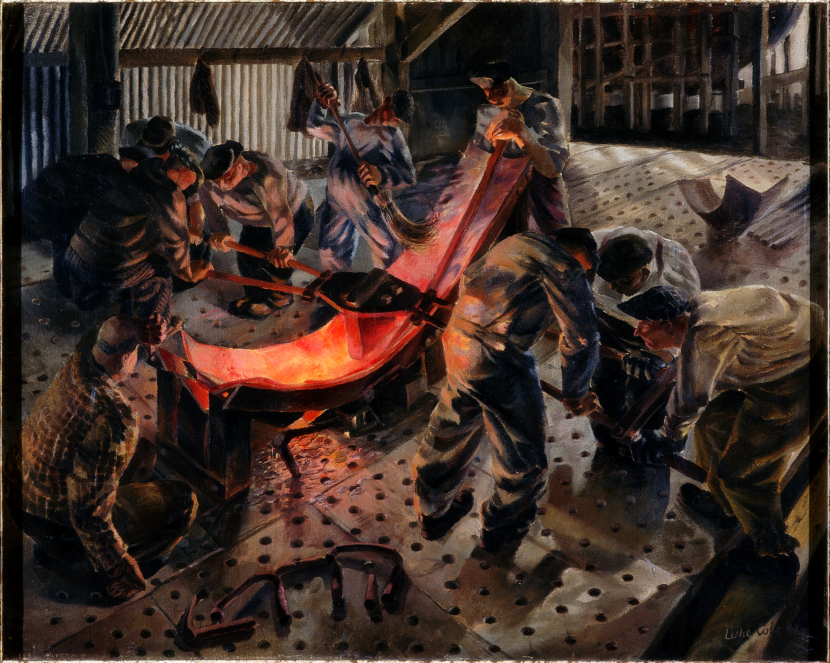The Laing Art Gallery’s new exhibition, With These Hands, explores the representation of craft in paintings, drawings, and prints. The process of making and mending by hand, whether a domestic pastime, rural and semi-industrial labour, or essential war effort, is a persistent theme to which artists return. Yet these artworks are rarely straightforward observations of everyday activity. Instead, the act of making is used to symbolise personal and communal identity, leisure and work, tradition and progress.
Produced in Britain and Europe from the 1750s onwards, the images in this exhibition reflect a society undergoing immense change. The growth of industry, the reorganisation of the methods and places of work, the changing status of women and the conflicts of World War I and II all impacted the value placed on hand skills. Some artists were interested in capturing traditions – their works romanticising crafts they perceived as almost lost – while others were drawn to the atmosphere and activity of the workshop and factory. With These Hands takes you from refined drawing rooms to weaving sheds, from a woodland saw pit to an inner city carpenter’s shop, and from country blacksmiths to industrial forges.
At a time when we are reassessing the importance of hand making, for mental health and environmental benefits, paintings and prints help us to understand our complex attitudes towards craft. The exhibition will bring together paintings and objects – quilts, embroidery, metalwork, wood carvings, ceramics and basketry – to explore both traditional techniques and contemporary approaches, encouraging connections across time and material.
With These Hands focuses particularly on the changing role of making in women’s lives. It shows how images of silent stitching were used to reinforce women’s place within 18th and 19th-century society. It includes portraits of 18th-century women, in which craft signifies status and the leisured and aristocratic lifestyle which these activities implied, and 19th and early 20th-century paintings of self-contained needlewomen in domestic interiors, undistracted by the world outside their windows. While some women found the home confining, busy hands could serve an active mind. Textiles could be a vital means of self-expression and other works capture the physicality and creativity of making as well as the continuing importance of craft as women embraced emancipation.
The exhibition also explores the relationship between craft and community. Figures are shown working in unison at the forge, in the carpenter’s workshop, or in the sail loft. Such communal working was idealised in the late 19th century. It was regarded as a symbol of continuity in a fragmenting society and used as inspiration for utopian communities centred around craft. The idea of craft as a collective endeavour took on a renewed, government promoted, importance during World Wars I and II as hand skills were seen as essential not only in the war effort but as part of British national identity. Many artists shifted focus, recording the interdependence of hand and machine and locating making in factories and garages.
One of the key undercurrents in the exhibition is a sense of nostalgia for craft skills which artists perceived as almost lost. Industrialisation, urbanisation, wartime bombing campaigns, and changing systems of art education have all been seen as threats to traditional craft skills. Painters and printmakers sought to record and preserve declining country crafts. However, by bringing together paintings and prints with finely crafted objects, With These Hands shows how in reality craft was never in stasis. Craft is always adapting and evolving.
Julie Milne, Chief Curator of Art Galleries at North East Museums, said: “This new exhibition explores the representation of craft in the visual arts. With crafting enjoying a resurgence and making by hand becoming more appreciated and valued in a digital age, this thoughtful and compelling exhibition explores the meanings these representations of craft hold. From personal and communal identity to leisure, work, tradition and progress, these images help us understand our complex attitudes to craft.
“I am delighted that this excellent exhibition draws on the strengths of the North East Museums art and craft collections along with loans from Tate, V&A, Royal Academy of Arts, Government Art Collection, Imperial War Museums and regional galleries.”
The exhibition features paintings and prints by artists including Mary Cassatt, G.F. Watts, Stanhope Forbes, Harold Knight, Evelyn Dunbar, and Ralph Hedley and objects by makers such as C. R. Ashbee, Bernard Leach, Michael Cardew, and local quilter Amy Emms.
Loans from Tate, V&A, Royal Academy of Arts, Imperial War Museums and regional galleries complement the strengths of North East Museums’ collections. Objects from the Shipley Art Gallery’s outstanding craft collections and the Discovery Museum’s textile collection are shown alongside paintings from the Laing.

